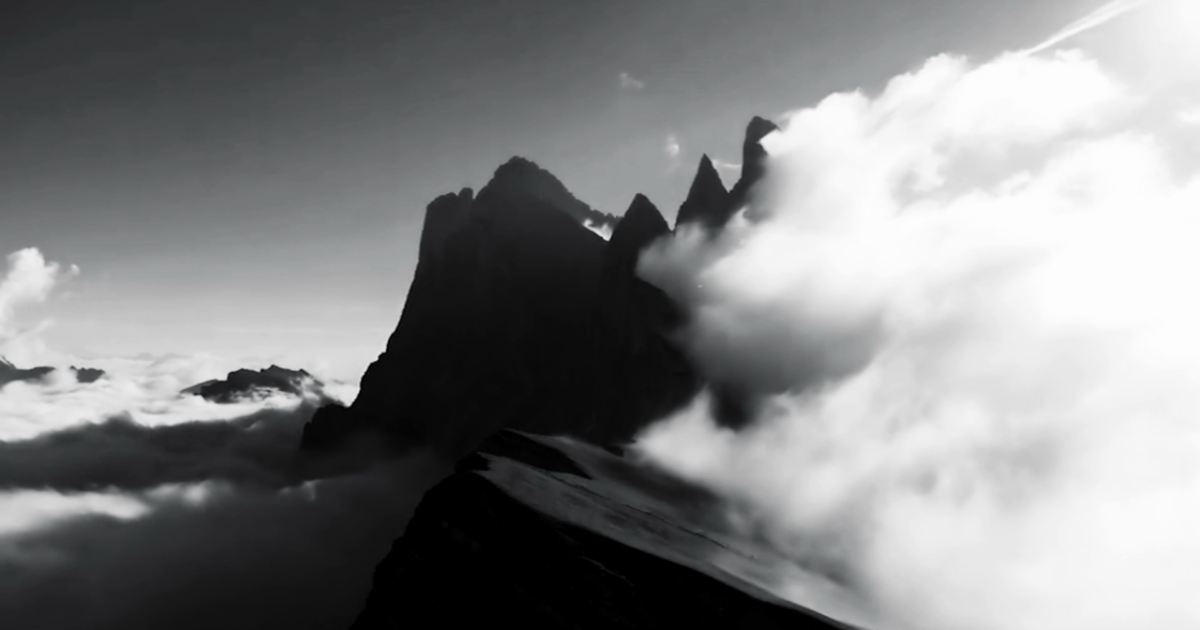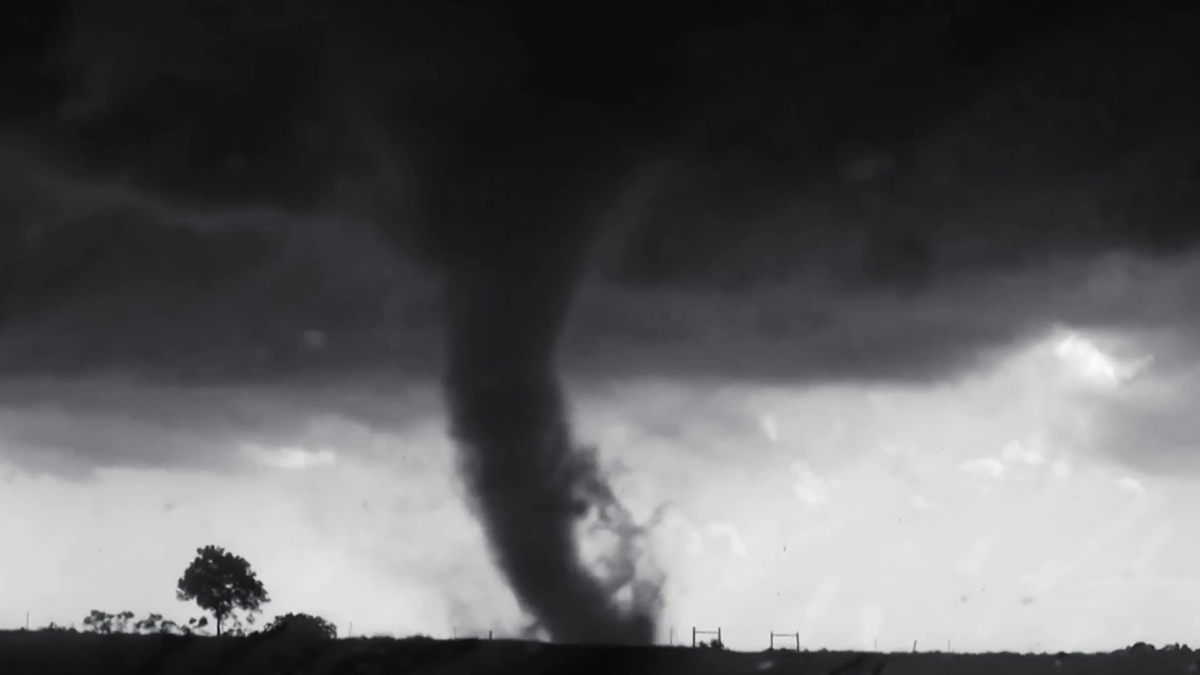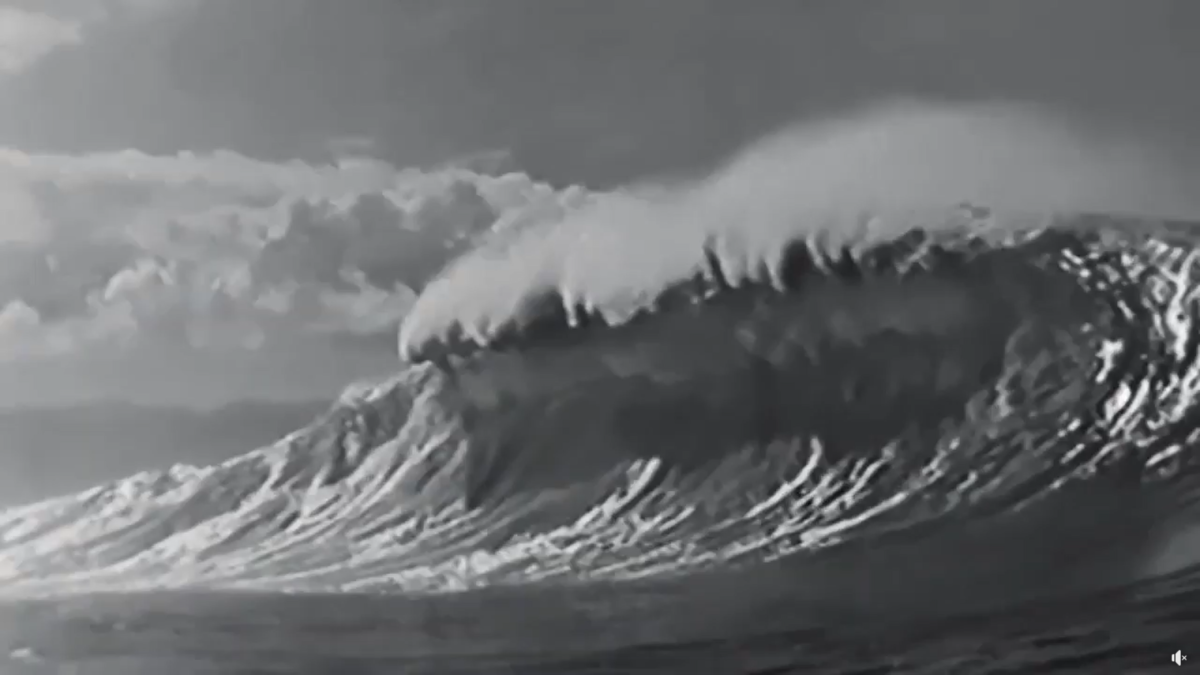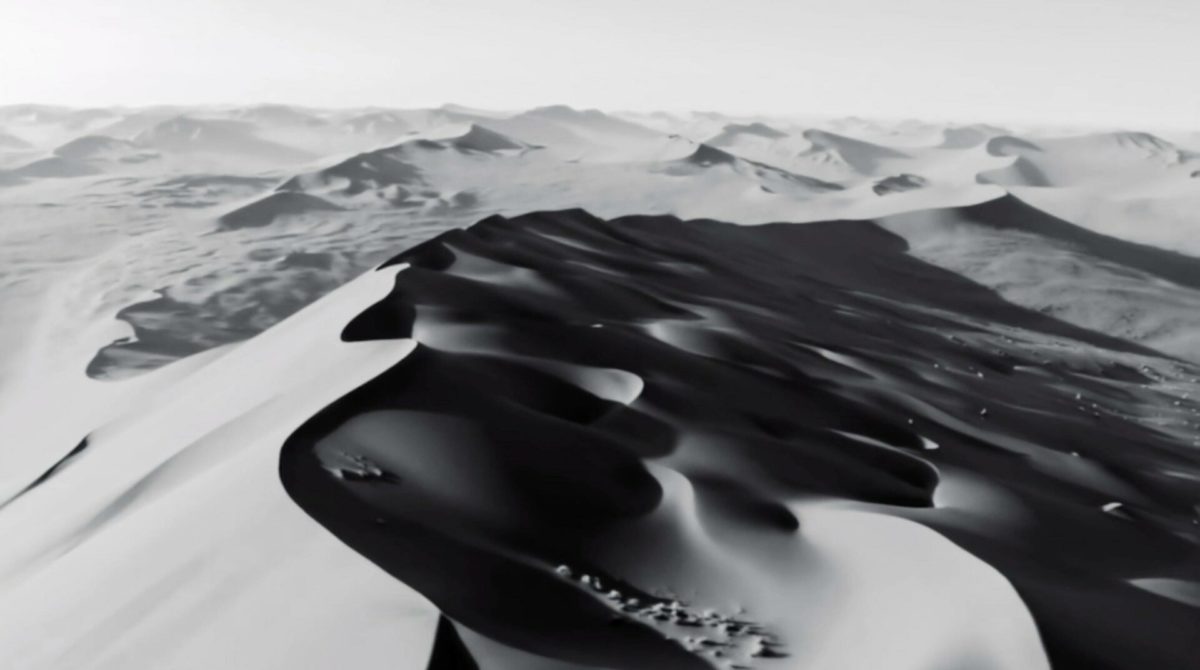2019 and 2020 saw the slightly surreptitious emergence of a strange object, stemming from another time and manufactured by one of cinema’s most unaccountable, errant minds: Artavazd Pelechian. Nature (2019) is the first film in 26 years from the sui generis Armenian filmmaker and theorist. First commissioned in 2005 by the Fondation Cartier pour l’art contemporain in Paris—which also screened the finished work as part of an exhibition devoted to Pelechian’s life and art in 2020––the film was melded over a period of 14 years by the filmmaker, aided by a team of researchers pulling from a range of archives. The result is a leviathan, a work of storm and stress and a weighty meditation on the destructive power of nature and humanity overwhelmed in its midst, composed entirely out of archival material, mostly digital, and tuned to black and white. The film has a much earlier origin point than 2005. Nature, a totalizing work, was extrapolated from a basis of nearly sixty years of filmmaking and theorization, undertaken by Pelechian himself, in continuation and contravention with the development of cinema as a modernist art during the silent era.

Flee! Out into the open, into four dimensions.
Born in 1938 in the Armenian SSR in the city of Leninakan (now Gyumri), and raised in Kirovakan (Vanadzor), Pelechian’s initial engagement with the possibilities of cinema was in 1963, when he moved to Moscow to attend the renowned Gerasimov Institute of Cinematography. There he hit the ground running, and began to develop a unique conception of cinema, which he explored in both theoretical works and in films. According to Pelechian, cinema possesses a chimeric nature as it’s both a “spatial and temporal art”. Like Sergei Eisenstein, Dziga Vertov and other key figures of the “heroic age of Soviet cinema”, as Hollis Frampton dubbed it, he deemed its key alchemizing agent and the true source of its power to be montage. Pelechian sought to maximise cinema’s enormous potential as a direct, tactile representation of the world and as a tool for deep forays into intellectual ideas, by using montage to reorder its principles. His films are not rhetorical or performative but visual and musical beasts, running according to tangible and proliferating lines of rhythm and rhymes, and therefore of thought, and not to the dictates of the human voice which has presided over much of narrative cinema.
The technique Pelechian employs, he dubbed ‘distance montage’ or ‘montage-at-a-distance’. As detailed in his 1971 essay, Montage-at-a-Distance, or: A Theory of Distance, it involves the recurring insertion of certain images and sounds, motifs as it were, put in different, contrapuntal arrangements with different combinations of such elements, so that different meanings are generated, developed and challenged throughout the film. That his technique applies to his use of sound as well is key. Pelechian, in many ways, represents a renewal of the Soviet formalists’ stifled hopes for a progressive sound cinema, which Eisenstein and Vertov had theorised but enacted with only a few films (such as Vertov’s Enthusiasm (1931) and key sequences found in Eisenstein’s Ivan the Terrible, Parts I & II (1944/58)) due to the smothering Stalinization of Soviet cinema in the 1930s. Pelechian’s approach was not to treat sound as vestigial, an unfortunate commercial imposition on the silent era’s high artistry, but as a profoundly expressive element that could be incontrovertibly tied to the image through montage in a newly unified cinematic art. As he states in his aforementioned essay:
One of the main issues in my work on this film was the montage of the visual and the aural. I tried to find the organic unity between the two, so that the visual and the aural can simultaneously express one and the same image, one and the same thought, one and the same affective sensation. So that the sound would be inextricably linked with the image, and the image would be inextricably linked with the sound! My starting point was, and still is, the fact that the only justification of the use of sound in my films should be, in a figurative way, its aesthetic function. We must find the critical expressiveness even in ambient noises and, if it is necessary, we must transform their resonance. That is why synchronous sound and voice-over commentary remain absent from my films.
Pelechian has generally worked in the short form and, in a very broad sense, what could be called non-fiction. However, as suggested in the above quote, he’s never conformed to any established documentary ‘genre’. His films are neither curated agitprop nor unbridled direct cinema. They never consistently conform to any particular didactic or observational approach, for their political import is almost always oblique and his extensive use of archival footage often dwarfs the amount of footage freshly captured by Pelechian and his crew.
Instead, his films are imbued with poetic, associative and intellectual motivations and effects to move their subjects to vivid yet metaphorical spaces, whether it concerns the October Revolution (Beginning (1967)), Armenian shepherds (Seasons of the Year (1975)), the Soviet space program (Our Century (1983)) or birth (Life (1993)). As entities and concepts that are repeatedly turned over and processed in a mind’s eye, ricocheted and digested in an ecstatic fever. His frequent use of classical and choral music often gives the impression of miniature, audio-visual serenades, or eulogies, etched with direct, realist details. He reinforces this strange alchemy in part by eluding such dialogic devices as voiceovers, interviews and only rarely employs intertitles, and never straightforwardly.

The Shaking of the Earth
Nature possesses these qualities on an even grander scale. It opens with harmonious landscapes. Slow zoom-ins and hovering helicopter shots of alpine peaks, calm watery expanses and rolling desert are set to a regular editing rhythm and to the resounding orchestral and choral arrangement of a Beethoven composition. Early on, one of the film’s most distinctive qualities becomes apparent: its jumble of footage shot at not only different locations and times, but in a cornucopia of different formats and even quality, as the clean, high-defined topography is interjected with faded video images. This morning aria does not last. Less than ten minutes in, there’s a literal and metaphorical eruption. The music cuts and there’s a spray of shots depicting volcanic activity, snapping glaciers, avalanches, landslides and earthquakes, with the music returning intermittently and dousing this cracking open of the earth in a sinister rather than heavenly glow.
This mayhem is rapidly brought down to ground level, with the bulk of the film’s midsection composed of a scramble of footage of natural disasters wreaking havoc on human settlements. The footage depicts the 2011 Great Kanto Earthquake, tornadoes and lightning storms striking the American Midwest, and other events, with the sources mainly amateur videos found on stock sites and public platforms like Shutterstock and YouTube. The weaving in of this less polished, more immediate footage allows the human beings to join the fray, though not as dominating subject but another, minute, element churning through this tempest, and as a haggard chorus of despair.
The deindividualized mass is a fixture in Pelechian’s cinema, though significantly not as an anonymous heap but as a collective imbued with strength and purpose. Take Season of the Year, which ends with a crew of hardy shepherds deftly cascading down a mountain slope, their sheep in tow like babes in arms. Pelechian highlights their skilfully navigated descent with music but also by slowing down the footage, giving it a balletic quality. Through prowess and experience, they have forged a co-dependency between themselves and with nature. In Nature, the human race is rendered as a denuded mass being violently dispersed by waves and wind, like a pane of glass shattering into a million tiny, dislocated pieces.
Pelechian expresses this fatal discord through a nonmetrical editing style and the periodic sublimating of the sweeping classical score in favour of a diegetic clamour. These found sounds he also re-arranges for metaphoric, or sheer visceral, emphasis. For instance, a sharply cut barrage of lightning strikes packs a particularly powerful, sonic impression of the destructive power of nature. It’s followed by an aerial shot surveying the aftermath of an earthquake which he accompanies with a dense bed of emergency vehicle sirens, as if an alarm bell is pealing all over the planet.
One of the film’s most curious aspects is the shape and position occupied by the voice, and its quashing under the yoke of an earthly logos. The only instances where a human being is heard is during those passages which emphasise the human cost of all this tumult, wherein barely discernible cries and shouts of alarm, warning and appeal to a higher power are sounded off.
This warp and weft of many individual voices into a floating aura is unlike what can be found in the vast majority of sound cinema, with even a figure like Robert Altman giving his overlapping, roughly recorded chatter high priority in his sound mixes. It’s reminiscent of another great explorer of a fearsome natural world, Robert Flaherty. A film like Man of Aran (1934), made when many national cinemas had already, full-fledged, abandoned silent film techniques, retains them while also exploring an approach to sound incommensurable to either silent cinema or the norms that succeeded it. An impassioned, orchestral score is interspersed with the sound of waves crashing against the shore. In between, we hear the voices of those on screen but not in the form of direct sound, an impossibility given the equipment of the day and the rough conditions. Neither are they recorded clearly and cleanly, post-sync, and then placed precisely in a close approximation of what is happening on-screen, as if to add some more realism ex post facto. Instead, his characters’ ‘dialogue’ is coagulated and delivered in clusters; a haze of exertions, instructions and cries of triumph that offer a modest but insistent counterpoint to the drumming beat of the ocean.
This is dogged human effort persisting in the face of an indomitable nature world. Expressed not didactically, as it is through the film’s intertitles and could have been with narration like that found in the work of John Grierson, Flaherty’s off-and-on colleague and admirer. Instead, it is powerfully metaphorized, and suited to an elemental artist like Flaherty. Pelechian paints a potentially bleaker impression of this collective voice repeatedly rising somewhat close to the fore and then being battered and broken up by other actants in the mix.

Noble Experiment
Sometimes people say that film is a synthesis of other art forms; I don’t think that’s true. In my view, it started at the Tower of Babel, where the division into different languages began. For technical reasons it first appeared after the other art forms, but in its nature, it precedes them. I try to make pure cinema, owing nothing to the other arts. I look for a setting that may create an emotional magnetic field around it.
Pelechian stated this in 1992, a few short years before his long sabbatical from active filmmaking, indicating a radical sea change in the beliefs informing his art that can be perceived, fully flowered, in Nature. In his aforementioned, manifesto-like essay, Pelechian is placing himself in a lineage with those montage artists that make some of the 20th century’s most important collective artistic endeavours—though even within that same essay and in his work, he also bucks against this partly-self, partly-outside imposed designation—sequestered within the century’s most important political projects, the Soviet Union. This man of science, who worked as metal worker and a draftsman for a state engineering company before embarking on his cinematic vocation, also uses Einstein’s general relativity to illustrate his thinking, and he states that the most quintessential definition of his technique is “A birth without a bearer: imagine a monster that devours the person from whom he came…” At first, it sounds like a mystical, wrong-footing utterance, and yet it is a metaphor for a key happening in the most modern conceptions of human history, agency and destiny: that of the ‘rupture’.
Pelechian of the 21st century, as summed up in Nature, seems not to hanker for and envision a rupture but a rapture. Instead of the shock of the new, cinema is like an ancient alien slumbering but active for centuries. His treatment of time for instance is very a-modern. In his prior work, Pelechian had already countered cinema’s, and modernity’s, relentless linearity with an eroding tendency towards cyclicality. It’s not only found in his themes but in how he constructs his films on a macro level, in the boomeranging of established motifs, and moment to moment, in how he often cuts from a shot to a mirrored version of the same shot, giving his frame a palpably ‘rounded’ aspect.
In Nature, the lack of demarcations, in terms of where and when we are at any moment, and how the desaturated palette also acts as an equalizer, gives the impression of a mythic mirror of our world. Though potentially overly abstracting qualities are countered, and the relationship to our own world left intact by the fact that this tapestry is also composed of very concrete, documentary images. This lack of signifiers includes a great silencing as well. Not only the absence but the active clearing away of a human presence until the film’s fugue of panicked voice, its tower of babel, has vanished. The final’s final image is an ambiguous reconfiguring of one its main motifs. A shot of the sea, previously calm, choppy and turbulent, now returned to a calm state, serenaded with morning birdsong, with an enormous sunset sinking into its depths. It’s the end and the beginning, for with the cooperation of silent film techniques and digital photography, Pelechian signals the conclusion of ‘noble experiment’. Our modern world and its mechanisms, consumed by a wounded nature which has renewed its timeless transcendence with a cut to black and silence.
